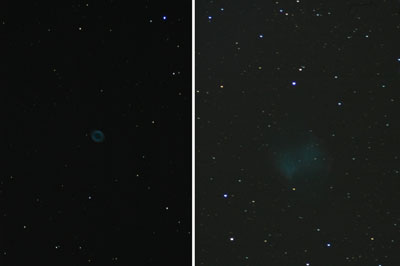When a star with approximately the size of our Sun dies, it blows off its outer shell. This shell contains all the elements that were generated by nuclear fusion in the course of its life, including oxygen and nitrogen. This outer part of the star is ejected in all directions and does not always have a spherical shape. Up to a certain distance, this cloud of gas is ionized by the residual radiation from the star and energized as an emission nebula to emit light. Planetary nebulae are therefore comparatively short-lived objects – once the gas envelope has moved far enough away from the dying star, it will be visible no longer. At the latest, after about 50,000 years, only the central star can be seen with a telescope while the gas masses are distributed unobtrusively in the universe.

Since planetary nebulae contain oxygen, they also give off green light. Therefore, on photographs they appear reddish or greenish, depending on whether it was photographed with a red-sensitive camera or a rather red-blind DSLR. The image of the digital camera rather corresponds to the sight you would have if the nebulae would be bright enough to be seen in color. With O-III filters they would be better to recognize but these filters are available only with a few binoculars.
Planetary nebulae owe their name to the fact that they look at low magnification just like small planets – there isn‘t much to see except for a small, usually circular disc. In typical binoculars most planetary nebulae appear only as very faint and slightly washed little stars which may be identified best by their slightly greenish color hue. The best known planetary nebula is the Ring Nebula M 57 in Lyra. It is in principle quite easy to see in a binocular – but only as an inconspicuous star which can be identified only with the help of a star chart in the star-rich environment. Planetary nebulae are therefore usually only interesting for telescope owners, although a few objects like the Helix Nebula have a large expansion and are fine objects for binoculars under dark skies.
